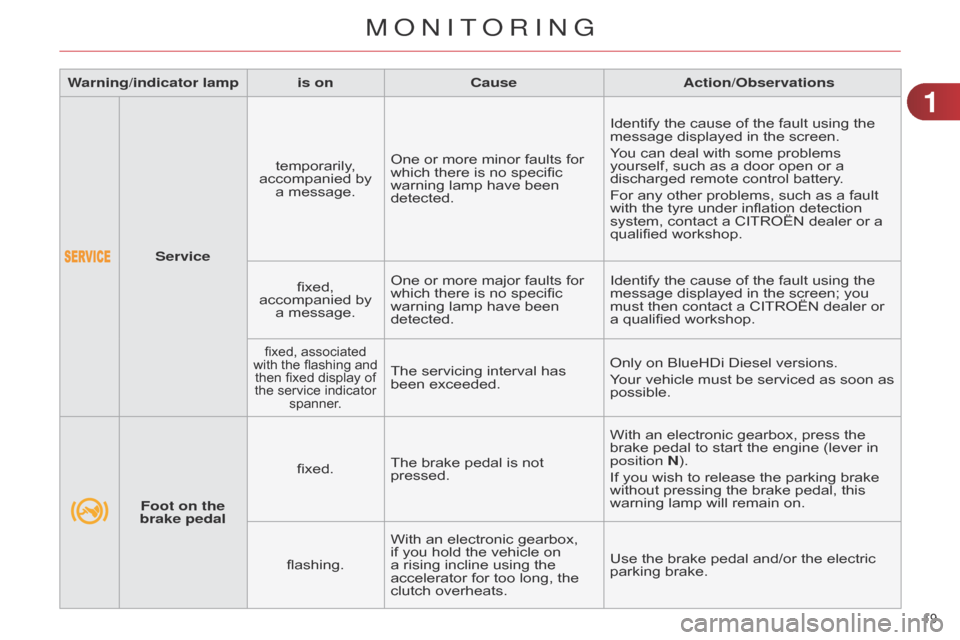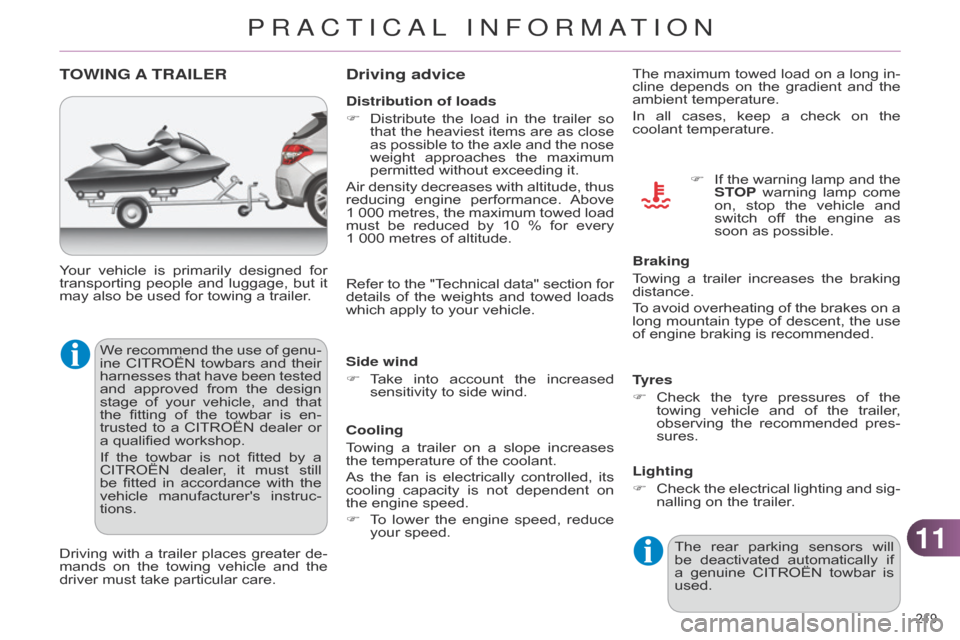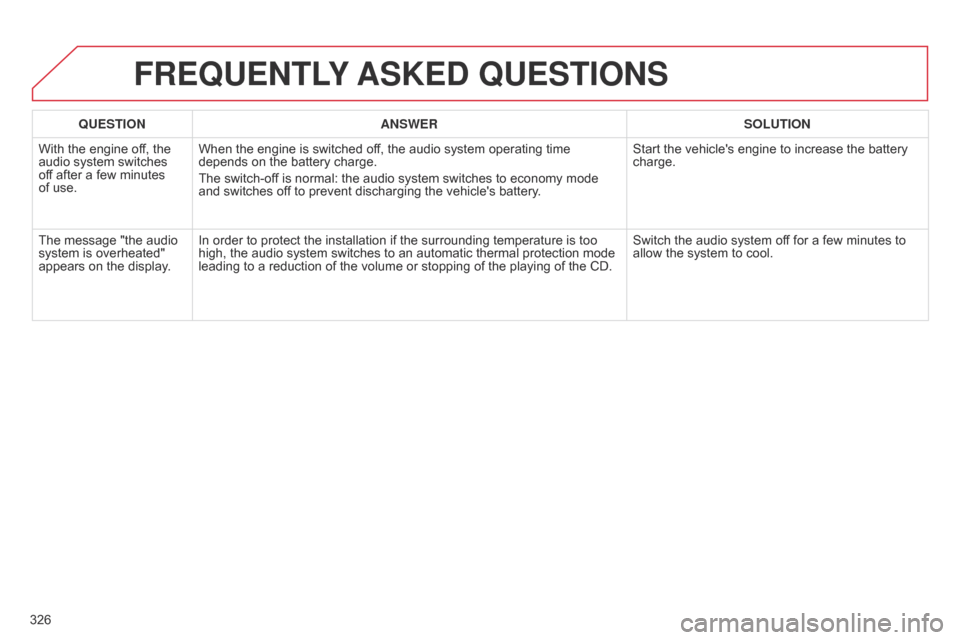engine overheat Citroen C4 DAG 2014.5 2.G Owner's Manual
[x] Cancel search | Manufacturer: CITROEN, Model Year: 2014.5, Model line: C4 DAG, Model: Citroen C4 DAG 2014.5 2.GPages: 340, PDF Size: 12.89 MB
Page 21 of 340

19
C4-2_en_Chap01_controle-de-marche_ed01-2014
Warning/indicator lampis onCause Action/Observations
Foot on the
brake pedal fixed.
The
brake pedal is not
pressed.With
an electronic gearbox, press the
brake
pedal to start the engine (lever in
position
N).
If
you wish to release the parking brake
without
pressing the brake pedal, this
warning
lamp will remain on.
flashing. With
an electronic gearbox,
if
you hold the vehicle on
a
rising incline using the
accelerator
for too long, the
clutch
overheats.Use
the brake pedal and/or the electric
parking
brake.
Service
temporarily,
accompanied
by
a
message.One
or more minor faults for
which
there is no specific
warning
lamp have been
detected.Identify
the cause of the fault using the
message
displayed in the screen.
You
can deal with some problems
yourself,
such as a door open or a
discharged
remote control battery.
For
any other problems, such as a fault
with
the tyre under inflation detection
system,
contact a CITROËN dealer or a
qualified
workshop.
fixed,
accompanied
by
a
message.One
or more major faults for
which
there is no specific
warning
lamp have been
detected.Identify
the cause of the fault using the
message
displayed in the screen; you
must
then contact a CITROËN dealer or
a
qualified workshop.
fixed, associated with the flashing and
then
fixed display of
the
service indicator
spanner
.
The servicing interval has been exceeded. Only
on BlueHDi Diesel versions.
Your vehicle must be serviced as soon as
possible.
1
MONITORING
Page 135 of 340

99
133
C4-2_en_Chap09_conduite_ed01-2014
A FEW DRIVING RECOMMENDATIONS
Observe the driving regulations at all times
and remain vigilant whatever the
traffic
conditions.
Pay
close
attention
to
the
traffic
and
keep
your
hands
on
the
wheel
so
that
you
are
ready
to
react
at
any
time
to
any
eventuality.
On
a
long
journey
,
a
break
every
two hours
is strongly recommended.
In
difficult
weather
,
drive
smoothly
,
an
-
ticipate
the
need
to
brake
and
increase
the
distance from other vehicles.
Driving on flooded roads
We strongly advise against driving on flooded
roads, as this could cause seri -
ous
damage
to
the
engine
or
gearbox,
as
well
as
to
the
electrical
systems
of
your
vehicle.
Important!
Never drive with the parking brake
applied - Risk of overheat -
ing
and
damage
to
the
braking
system!
Do
not
park
or
run
the
engine when
stationary in areas where
inflammable substances and ma -terials (dry grass, dead leaves...) might
come into contact with the hot
exhaust
system
-
Risk
of
fire!
n
ever leave a vehicle unsuper-
vised
with
the
engine
running.
If
you have to leave your vehicle
with
the
engine
running,
apply
the
parking
brake
and
put
the
gearbox
into
neutral
or
posi
-
tion
N
or P,
depending
on
the
type
of gearbox.
If
you
are
obliged
to
drive
through
water:
-
check
that
the
depth
of
water
does
not
exceed
15
cm,
taking
account
of
waves
that
might
be
generated
by
other users,
-
deactivate
the
Stop
&
Start
system,
-
drive
as
slowly
as
possible
without
stallin
g.
In
all
cases,
do
not
exceed
6
mph
(10
km/h),
-
do
not
stop
and
do
not
switch
of
f
the
engine.
On
leaving
the
flooded
road,
as
soon
as
circumstances
allow
,
make
several
light
brake
applications
to
dry
the
brake
discs
and
pads.
If
in
doubt
on
the
state
of
your
vehicle,
contact
a
CITROËN
dealer
or
a
quali
-
fied
workshop.
DRIVING
Page 221 of 340

1111
219
C4-2_en_Chap11_info-pratique_ed01-2014
TOWING A TRAILER
We recommend the use of genu -
ine CITROËN towbars and their
harnesses
that
have
been
tested
and
approved
from
the
design
stage
of
your
vehicle,
and
that
the
fitting
of
the
towbar
is
en
-
trusted
to
a
CITROËN
dealer
or
a
qualified workshop.
If
the
towbar
is
not
fitted
by
a
CITROËN
dealer
,
it
must
still
be
fitted
in
accordance
with
the
vehicle
manufacturer's
instruc
-
tions.
Your
vehicle
is
primarily
designed
for
transporting
people
and
luggage,
but
it
may
also be used for towing a trailer.
Driving
with
a
trailer
places
greater
de
-
mands
on
the
towing
vehicle
and
the
driver
must take particular care.
Driving advice
Distribution of loads
F
Distribute
the
load
in
the
trailer
so
that
the
heaviest
items
are
as
close
as
possible
to
the
axle
and
the
nose
weight
approaches
the
maximum
permitted
without exceeding it.
Air
density
decreases
with
altitude,
thus
reducing
engine
performance.
Above
1
000
metres,
the
maximum
towed
load
must
be
reduced
by
10
%
for
every
1 000
metres of altitude.
Side wind
F
T
ake
into
account
the
increased
sensitivity
to side wind.
Cooling
Towing
a
trailer
on
a
slope
increases
the
temperature of the coolant.
As
the
fan
is
electrically
controlled,
its
cooling
capacity
is
not
dependent
on
the
engine speed.
F
T
o
lower
the
engine
speed,
reduce
your
speed. The
maximum
towed
load
on
a
long
in
-
cline depends on the gradient and the ambient
temperature.
In all cases, keep a check on the
coolant
temperature.
F
If
the
warning
lamp
and
the
ST
OP
warning
lamp
come
on,
stop
the
vehicle
and
switch
of
f
the
engine
as
soon
as possible.
Braking
Towing
a
trailer
increases
the
braking
distance.
T
o
avoid
overheating
of
the
brakes
on
a
long
mountain
type
of
descent,
the
use
of
engine braking is recommended.
Tyres
F
Check
the
tyre
pressures
of
the
towing
vehicle
and
of
the
trailer
,
observing
the
recommended
pres
-
sures.
Lighting
F
Check
the
electrical
lighting
and
sig
-
nalling
on the trailer.
Refer
to
the
"T
echnical
data"
section
for
details
of
the
weights
and
towed
loads
which
apply to your vehicle.
The
rear
parking
sensors
will
be
deactivated
automatically
if
a
genuine
CITROËN
towbar
is
used.
PRACTICAL INFORMATION
Page 328 of 340

326
C4-2_en_Chap13c_RD5_ed01-2014
FREqUENTLY ASKED q UESTIONS
qUESTION ANSWER SOLUTION
With
the engine off, the
audio
system switches
of
f
after a few minutes
of
use. When
the engine is switched off, the audio system operating time
depends
on the battery charge.
The
switch-off is normal: the audio system switches to economy mode
and
switches off to prevent discharging the vehicle's battery.Start
the vehicle's engine to increase the battery
charge.
The
message "the audio
system
is overheated"
appears
on the display. In
order to protect the installation if the surrounding temperature is too
high,
the audio system switches to an automatic thermal protection mode
leading
to a reduction of the volume or stopping of the playing of the CD.Switch
the audio system off for a few minutes to
allow
the system to cool.